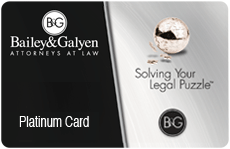Steps You Can Take to Prevent Winter Automobile Accidents This Year
 Winter is just around the corner and while driving in Texas this time of year typically doesn’t compare to many northern climates, where you might have a foot of snow in a single storm, the Lone Star State is notorious for icy and treacherous roadways from November through March. Statistics indicate that the number of accidents nationwide tends to go up during the winter months, though the number of traffic fatalities tends to decrease. Why are there more motor vehicle crashes in the winter? What can you do to reduce the risk of accident and injury?
Winter is just around the corner and while driving in Texas this time of year typically doesn’t compare to many northern climates, where you might have a foot of snow in a single storm, the Lone Star State is notorious for icy and treacherous roadways from November through March. Statistics indicate that the number of accidents nationwide tends to go up during the winter months, though the number of traffic fatalities tends to decrease. Why are there more motor vehicle crashes in the winter? What can you do to reduce the risk of accident and injury?
The Common Causes of Winter Traffic Accidents
Many of the causes associated with motor vehicle accidents in icy or snow weather are not directly tied to weather conditions. Among the most common are:
- Distracted driving, where a motorist is paying attention to a handheld device, the car stereo, a passenger, personal grooming or a roadside attraction at the time of the crash
- Drinking and driving
- Driving without adequate sleep or rest
- Aggressive driving
There are, however, some factors directly related to the weather that can increase the risk of a motor vehicle accident:
- A failure by a motorist to take the weather conditions into account—A driver may not change speed or other driving habits, even though conditions warrant slower driving or maintaining greater distance between your vehicle and the one in front of you
- A failure by a motorist to adequately remove snow or ice from the hood or windshield of a vehicle, making it difficult or impossible to see other traffic or the road ahead
Things You Can Do to Minimize the Risk of a Motor Vehicle Wreck This Winter
While you can never guarantee your safety on the roads, there are measures that you can take to minimize the risk of accident and injury:
- Make certain your vehicle is ready for the road—You want good tires with ample tread and you want to make certain you have appropriate tire pressure. Before winter hits, have your mechanic take a good look at your brakes. All vehicle lights should work properly and your vehicle defrost/heater should keep your windows free of condensation, snow and ice. Always have at least a half a tank of gas and keep your windshield washer fluid tank full, if possible. Put new wiper blades on at the beginning of the cold season.
- Be reasonably cautious on the roadways—When there’s snow or ice on the roads, it’s going to take you longer to stop (and it may take you longer to get started). Give yourself plenty of room to stop and keep your speed down a little, so that you won’t need as much room to stop. Don’t creep along, though—that can put you at risk of being rear-ended. Never slam on your brakes—instead, gently tap them as you slow down. Likewise, when you pull away from an intersection, don’t give the vehicle too much gas—you’ll just spin your tires and may dart out into traffic if you suddenly get traction. Ease up on the brake and let the car start to move forward on its own, gently accelerating to a safe speed. Don’t use cruise control on snowy or icy roads…you want more control of your speed.
Let the Experienced Attorneys at Bailey & Galyen Help after a Personal Injury
At the law offices of Bailey & Galyen, we bring more than four decades of proven experience to people across the Lone Star State who have been hurt in any type of accident. We know that the civil justice system can be confusing and intimidating and will take the time to carefully explain the process at every juncture. Contact us by e-mail or 844-402-2992 call our offices at one of the convenient locations listed below. Our phones are answered 24 hours a day, seven days a week.








